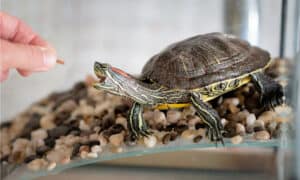The name “musk turtle” refers to three genera of aquatic turtles belonging to the Kinosternidae family. Those genera include Sternotherus, Staurotypus, and Claudius and contain around nine species. Musk turtles get their name from the unpleasant musky odor they produce from their scent glands to deter predators.
These turtles can range in size depending on their species, but they are all omnivores inhabiting freshwater environments. These entirely aquatic turtles are found in wetlands throughout Central and North America. Only a handful of musk turtle species are kept as pets.
Overview of Musk Turtles

Musk turtles can vary in size and appearance depending on the species.
©iStock.com/AntonyMoran
| Family: | Kinosternidae |
| Origins: | Central and North America |
| Size (length): | 3 to 15 inches |
| Weight: | 1 to 20 pounds |
| Lifespan: | 20 to 60 years |
| Diet: | Carnivorous or omnivorous |
| Behavior: | Nocturnal |
1. Sternotherus Species:
- Eastern musk turtle (S. odoratus)
- Flattened musk turtle (S. depressus)
- Loggerhead musk turtle (S. minor)
- Razor-backed musk turtle (S. carinatus)
- Stripe-necked musk turtle (S. minor peltifer)
- Aliflora musk turtle (S. intermedius)
2. Staurotypus Species:
These two species are native to Mexico and North America:
- Pacific coast giant musk turtle (Staurotypus salvinii)
- Northern giant musk turtle (Staurotypus triporcatus)
3. Claudius Species:
- Narrow-bridged musk turtle (Claudius angustatus)
Specie Origins and Natural Habitat
Musk turtles are endemic to North America and Central America, specifically in Mexico and the United States. Populations of the Sternotherus genus can be found in Alabama, Missouri, Florida, Georgia, Maine, and Ontario, Canada. Pacific giant musk turtles are found in the Pacific drainages of Chiapas and Oaxaca. Like the northern musk turtle, they can be found in Guatemala, Tabasco, Belize, and El Salvador too. Their natural habitat consists of slow-moving shallow ponds or rivers with ample vegetation and soft substrates.
A Guide to Different Musk Turtle Sizes and General Appearance
Each species of musk turtle varies in size and appearance. Species in the Sternotherus genus look similar, with the main differences being their carapace (upper shell) shape and size. The northern giant musk turtle is the largest species, with an average size of 15 inches. Whereas the stripped-neck musk turtle is the smallest at only 3 to 5 inches long.
Sternotherus Sizes
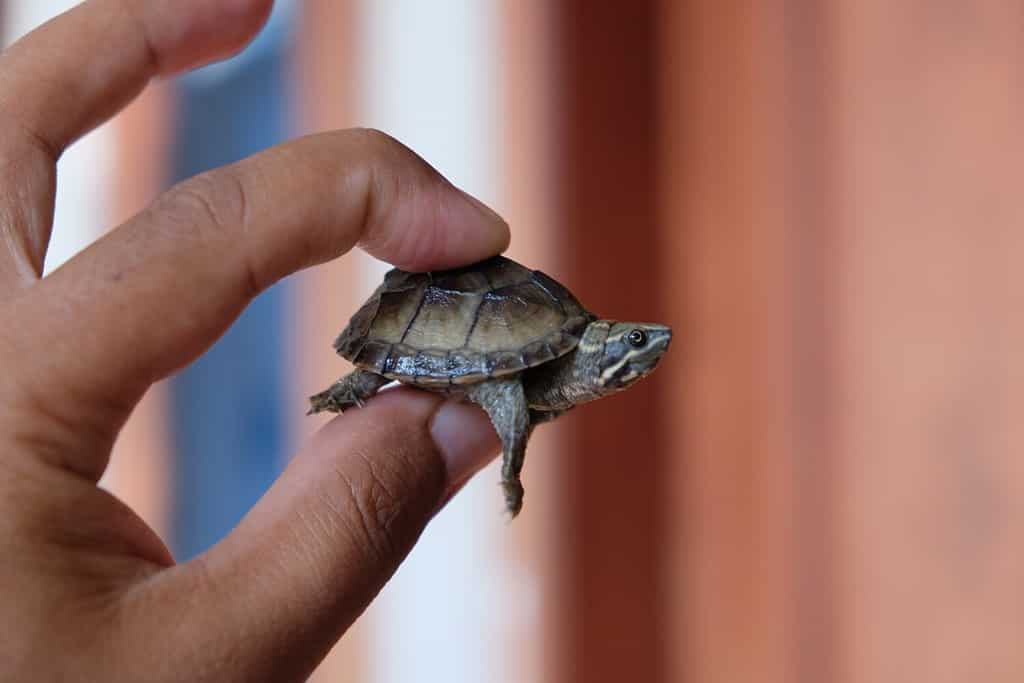
The eastern musk turtle is the smallest turtle in Missouri at 4 to 6 inches long.
©forest warrior/Shutterstock.com
The eastern musk turtle grows to 4 to 6 inches long, making them one of the smallest turtles in the world. Their carapace is a dark brown coloration with slight black flecks throughout. The rest of their body is a brownish color with yellow or tan markings. Juvenile eastern musk turtles have a highly domed shell and light-yellow facial markings that are less visible in adults. One of this species’ most prominent features is their pig-like nose at the end of their elongated snouts.
Flattened musk turtles reach around 5 inches in size, making them a small turtle species found in Alabama. They get their name from their compressed carapace which is flatter than the other species. Their carapace is an off-yellow or brown color, and their body is covered in leopard-like markings. Loggerhead musk turtles are small at 4 to 5 inches long and recognized by their larger head than other species. The stripe-necked musk turtle is the subspecies of the loggerhead and grows between 3 to 4 inches.
Razor-backed musk turtles stand out with their brown carapace with a distinctive sharp and raised keel down the center. This species can reach 6 inches as an adult, but some only grow to 5 inches. The aliflora or intermediate musk turtle has a striped head with spotting, and adults grow between 4 to 5 inches long.
Staurotypus Sizes
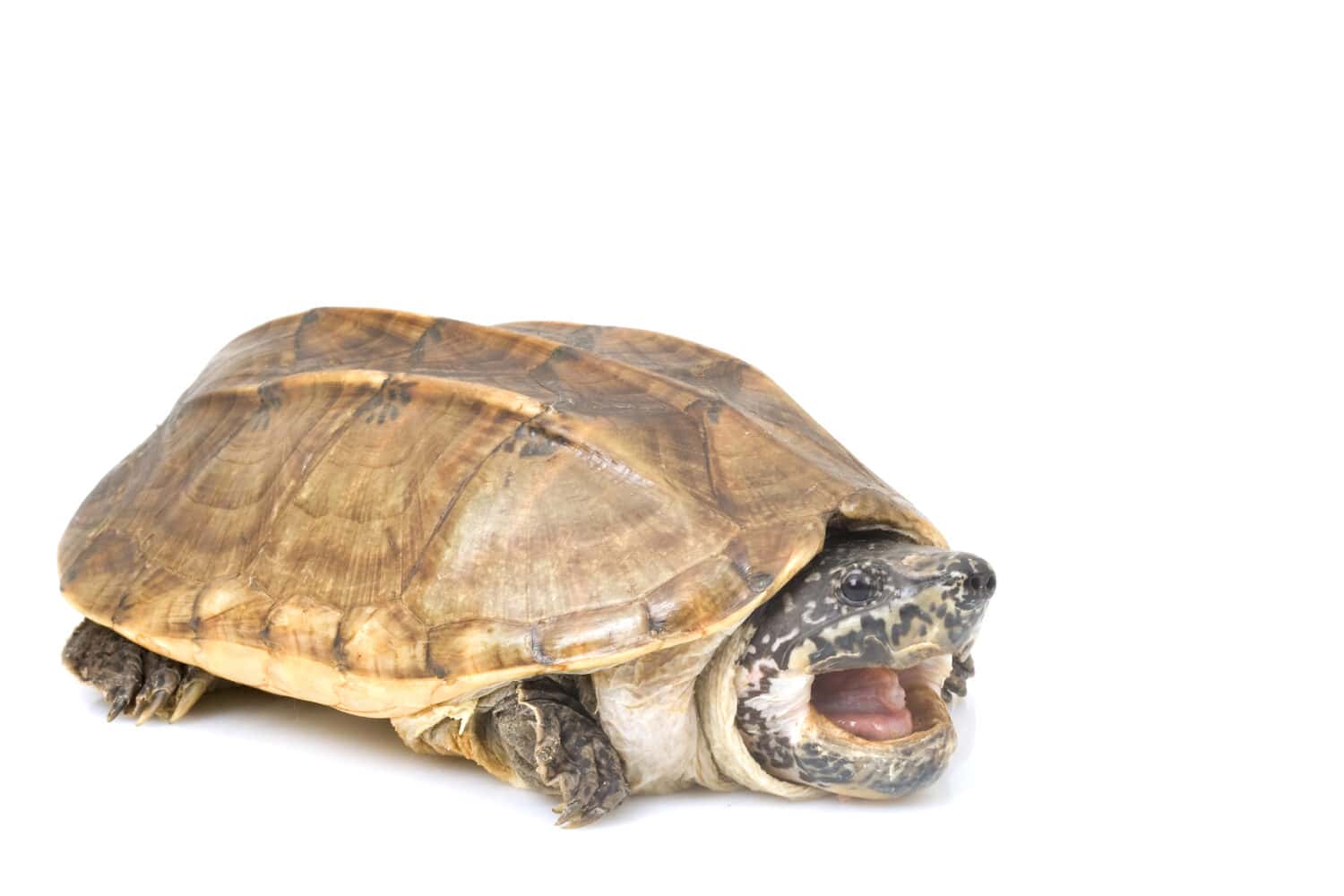
The northern giant musk turtle reaches 15 inches in length.
©fivespots/Shutterstock.com
The two species from the Staurotypus genus are true to the “giant” in their name. They are much larger than other musk turtles with an average size of 15 inches. The Pacific coast giant musk turtle grows between 10 to 15 inches long, whereas the northern giant musk turtle is the largest with an average carapace size of 15 inches.
These two species can be told apart by their appearance. Pacific coast giant musk turtles have greenish-brown carapace and brown limbs. Their carapace is flatter than the northern giant musk turtle whose carapace is longer, and more dome shaped.
Claudius Size
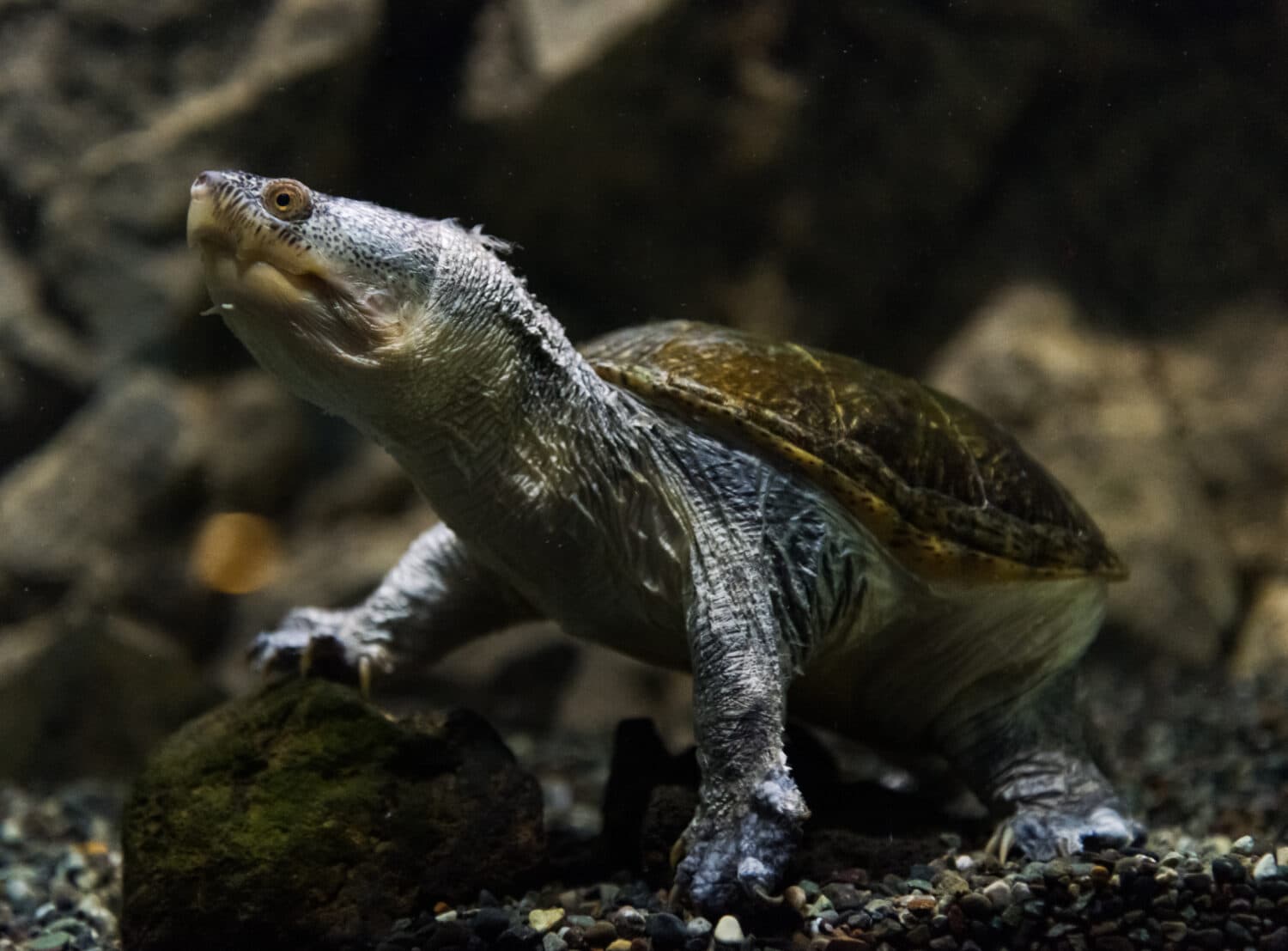
The narrow-bridged musk turtle is the only extant member of the genus
Claudius.
©LEE EUI-ZUN/Shutterstock.com
Narrow-bridged musk turtles are slightly larger than the genus Sternotherus species but smaller than the Staurotypus turtles. They have an average adult size of 6.5 inches with a brown carapace, elongated neck, and bulbous head.
Male vs. Female Musk Turtle Size
Female musk turtles generally have a larger carapace than males and therefore longer bodies. However, male musk turtles tend to have larger heads and thicker tails.
Musk Turtle Lifespans

All species of musk turtles have long lifespans averaging 20 to 60 years. They typically live longer in captivity than they do in the wild since there are fewer disease and predation risks. The eastern musk turtle’s captive lifespan is between 30 to 50 years with proper care. In the wild, musk turtles usually live significantly shorter for around 15 to 20 years.
Ensuring that your pet musk turtle is cared for properly and has access to medical treatment helps to extend their lifespan. Keep in mind that a musk turtle’s lengthy lifespan makes them a lifelong commitment for most people. So, ensure that you can care for a pet musk turtle for the next few decades of your life before getting one.
Caring for Musk Turtles
Which Species of Musk Turtles Are Kept As Pets?
The most common species kept as pets is the S. odoratus, which is our main focus throughout this care section. Names for this species include the stinkpot, common, or eastern musk turtle.
Other species of musk turtle are kept as pets too, although they are not as popular as the eastern musk turtle. You can find razor-backed, loggerhead, stripe-necked, and Pacific coast giant musk turtles in the pet trade. The flattened musk turtle is prohibited from being traded as a pet and is listed as critically endangered by the IUCN Red List.
Habitat
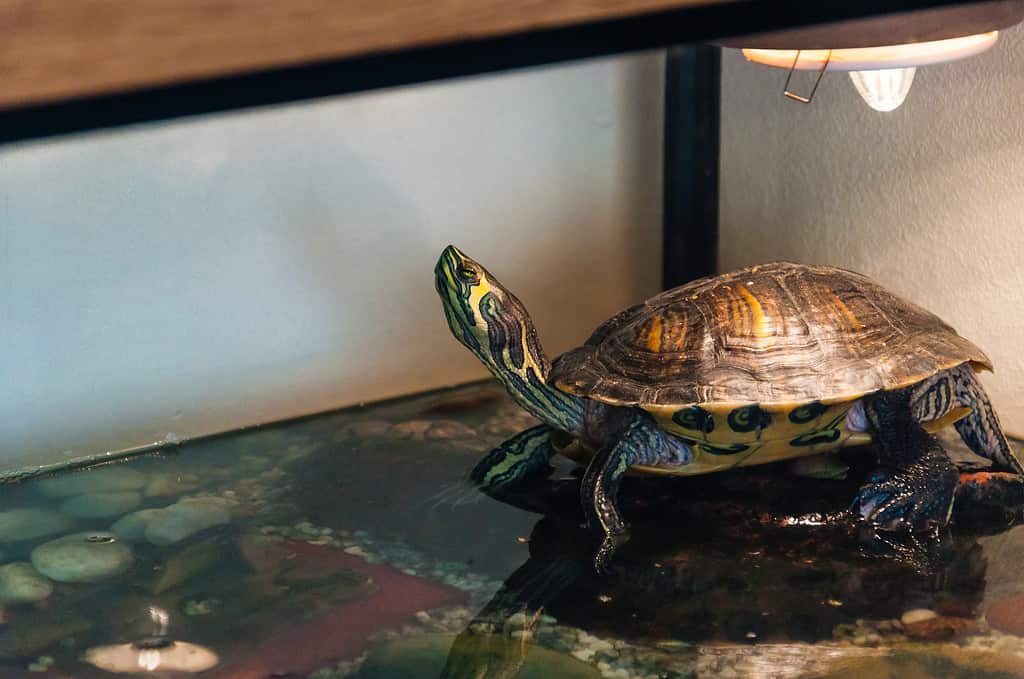
Musk turtles require a basking spot in their habitat for warmth.
©YKD/iStock via Getty Images
Musk turtles require a spacious and secure habitat to thrive. Their habitat should be over 20 gallons in size, ideally 40 to 55 gallons for full-grown adults. Although they are fully aquatic turtles, they still need a dry area out of the water to bask.
Most of their habitat should be freshwater, with a basking platform and ramp in another section. Musk turtles need an efficient filter to keep their water fresh and prevent stagnation. However, the filter should produce a low to moderate current as these turtles originate from slow-moving waters.
Adding live or fake plants in their habitat is encouraged to make them feel secure. Using a substrate in your musk turtle’s habitat is optional, but a thin layer of sand or gravel is preferred.
Water Quality
Good water quality is essential for your musk turtle. They should only be kept in habitats that have been fully cycled weeks before they are added. Cycling the habitat allows beneficial bacteria from the nitrogen cycle to establish and effectively convert your musk turtles’ waste to safer forms. You will need to use a freshwater liquid testing kit to get an accurate reading of the tank’s water parameters.
A musk turtle’s tank should ideally have zero traces of ammonia and nitrite, with nitrates being tolerable until 30 ppm. The pH of the water should remain between 6.5 to 7.5 with few fluctuations.
Diet
Musk turtles are omnivorous turtles but tend to eat more carnivorous foods. Their wild diet consists of various invertebrates, plants, carrion, and small fish. In captivity, a musk turtle’s diet should be high in animal-based foods and lower in aquatic plants or leafy greens.
Pet musk turtles should get most of their nutrients from live foods (such as insects, earthworms, shrimp, and snails), leafy greens, and a low protein and high calcium turtle pellet. You want to limit the amount of processed food in their diet and avoid leafy greens high in phosphorus. Their food should ideally be dusted with a reptile calcium or vitamin supplement a few times a week.
Adult musk turtles eat less often than hatchlings and juveniles. Young musk turtles should eat daily and adults every two to three days.
Temperature and Heating
Musk turtles are reptiles that rely on external heat for temperature regulation. In the wild, they will surface to bask under the warm sunlight. The sunlight also provides them with essential UV rays needed for certain bodily functions like vitamin D3 synthesis.
Musk turtles require a basking spot in their habitat, along with consistent warm temperatures. The temperature under their basking spot should be set to around 85° to 92° Fahrenheit. The basking lamp should shine down on a basking platform that your musk turtle can easily access. The rest of the habitat should remain between 75° to 79° Fahrenheit with an aquarium heater.
At night, the basking lamps and lighting should be turned off and the temperature may gradually drop to 68° Fahrenheit.
Lighting
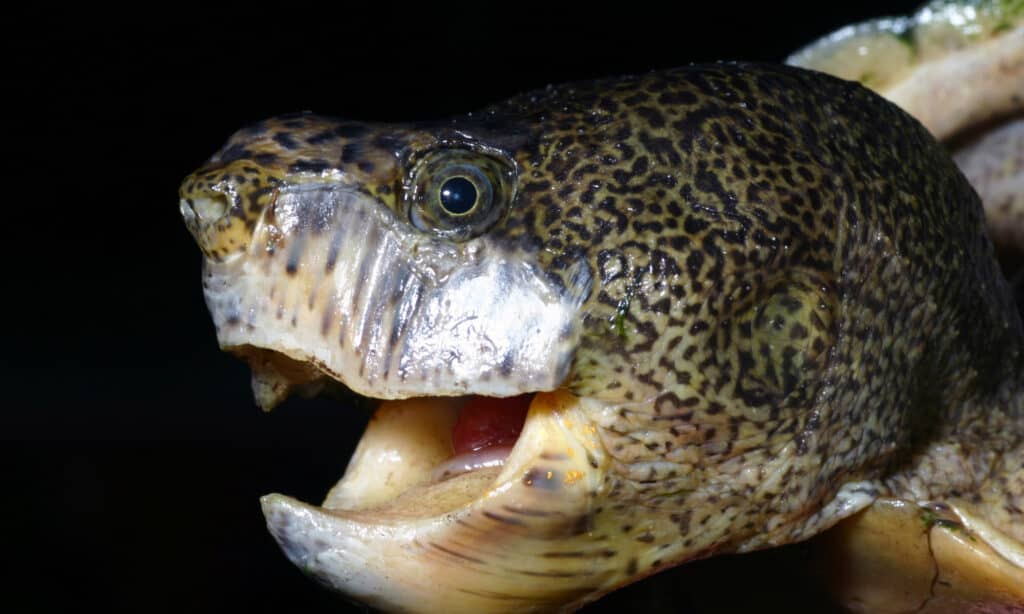
The loggerhead musk turtle has a pig-like nose.
©Michael Benard/Shutterstock.com
Lighting for your musk turtle’s habitat is important, as they should not be kept in darkness during the day. Musk turtles require lighting with both UVB and UVA which is a necessity for many reptiles. Not all reptile basking bulbs produce essential UV rays, so an additional lighting source that does is important. The UV bulbs should be placed in areas where your musk turtle basks so that they can receive the full benefits.
Health Conditions
As with any other pet, musk turtles can fall ill and require veterinary care. Proper husbandry is the best way to keep your musk turtle healthy and help prevent potential health conditions. Some of the more common health conditions for musk turtles include parasites, shell rot, diarrhea, and metabolic bone disease (MBD). If you suspect that your musk turtle is ill, you need to take them to an exotic veterinarian right away.
Quick Recap
Musk turtles can be any of the several species or subspecies from three genera. These turtles are endemic to parts of North and Central America and belong in freshwater habitats. Musk turtles can range in size from 3 to 15 inches long, with the genus Sternotherus containing the smallest species.
Only a few species of musk turtles are kept as pets, with the most common species being the S. odoratus. Caring for your pet musk turtle properly is the best way to allow them to live a healthy and long life.
The photo featured at the top of this post is © fivespots/Shutterstock.com
Thank you for reading! Have some feedback for us? Contact the AZ Animals editorial team.




